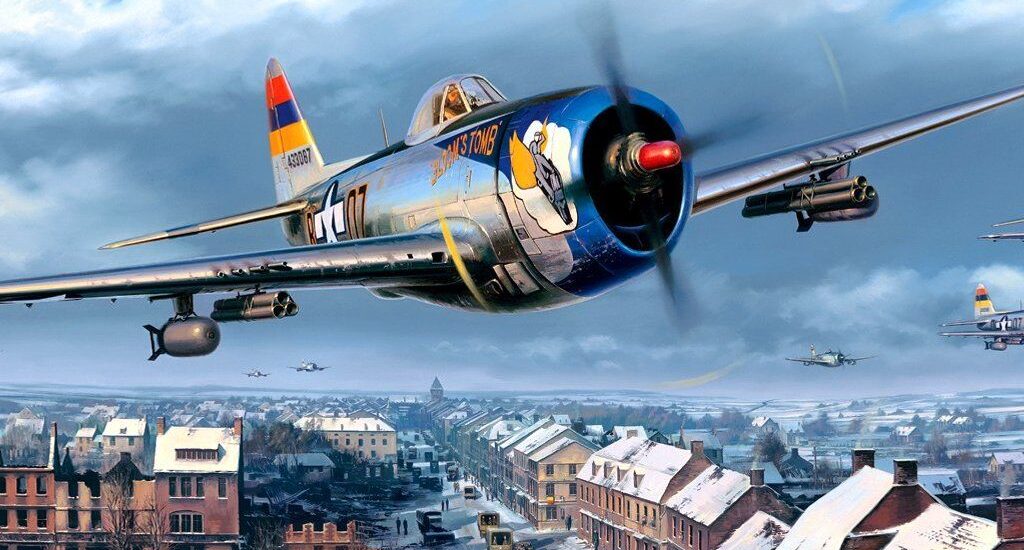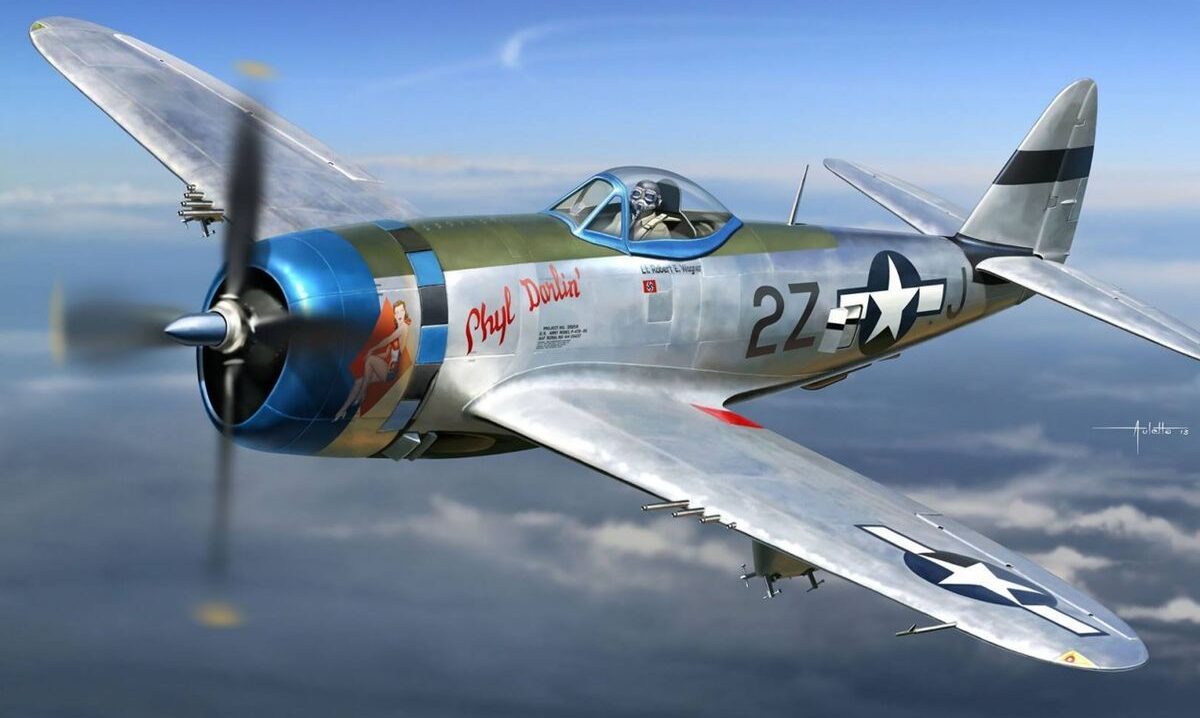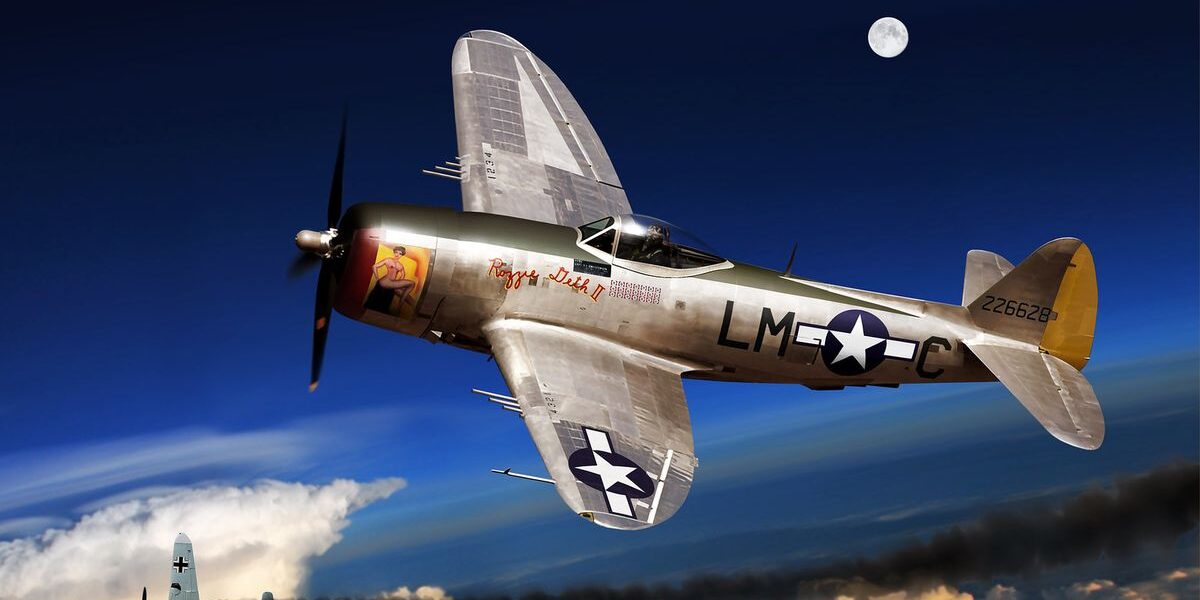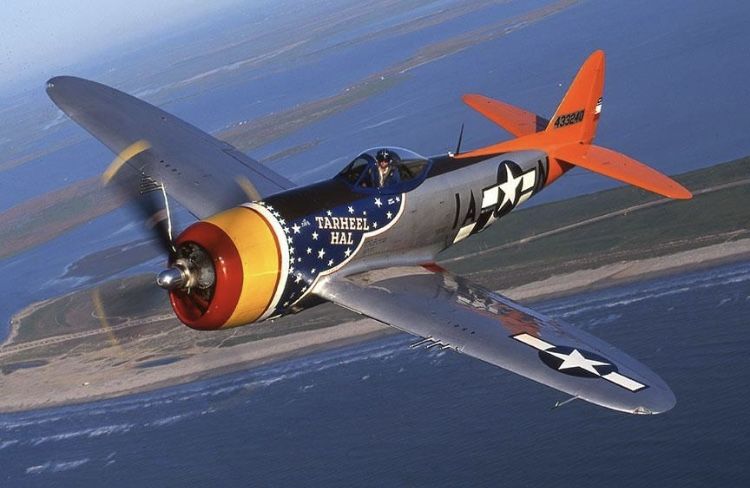The P-47 Fighter Aircraft had its origins in June 1940, when Republic designer Alexander Cartwley proposed building a fighter with the new Pratt & Whitney R-2800 twin-row radial engines, turbo-supercharged, for high-altitude flight. There were problems controlling the power of the huge engines, and the initial shape did not fly until June 1941. Production began only in March 1942, and even then difficulties arose because of the shock waves generated when the local airspeed reached the speed of sound, which caused the controls to “stuck” and in some cases even lock up during high-altitude flight. Allocentric controls were eventually discarded, but theP-47 Fighter Aircraft did not enter combat in Europe until mid-April 1943.

Allied fighter aircraft and fighter-bombers flown by the Allied air forces in World War II. Republic P-47 Fighter Aircraft Aviation. A single-seat low-wing fighter aircraft built by the United States Air Force (USAAF), it was the largest single-engined fighter aircraft ever built. Design Features and Specifications
The Design of the P-47 Fighter Aircraft
By George C. Larson, September 1, 1982
In June 1940 a few men gathered in a room at Wright Field, OK outside Dayton, Ohio. No one could have imagined what they would feel. For five months, Nazi bombing had spread like liquid fire across Western Europe, and in May the Dunkirk salvos left England alone among the Allies not occupied by Hitler. The American “neutrality” of the previous year had now become a mere memory as Washington prepared to ship massive amounts of war equipment to Britain.
There was one thing even more astonishing than the lightning-like pace of the war: the complete lack of military buildup in the US. This was the situation that was being organized to advantage seventeen years ago at Wright Field.
Just hours earlier, on June 19, General H.H. Arnold’s John Hancock delivered the report of the MNS Board (named for Major General Delos C. MNS, then commander of GHQ Air Force), which had concluded earlier that year that most, if not all, of the Army’s aircraft then in service, built with the iconic Allison V-1710, would be unfit for combat.
The meeting was attended by Lieutenant Colonel Howard Z. Bogert and Major Franklin O. Carroll of the Material Division’s Engineering Division; Captain Marshall “Mish” Roth, project officer; Julius Hulman of the Power Plant Division; Paul B. Smith of the technical staff; and Major Lawrence “Bill” Craigie, Bogert’s assistant.
The meeting was also attended by two Republic Aircraft officials; C. Hart Miller, vice president of sales, and Alexander “Sasha” Cartwley, vice president of engineering.
Republic P-47 Thunderbolt
Republic P-47 Thunderbolt, 1944 Four U.S. Army Air Forces variants flew one after another.
A total of 15,683 Thunderbolt aircraft were built by the end of the war, more than any other U.S. fighter aircraft. The P-47D, which became available for general service in the spring of 1944, had a maximum speed of 440 miles (700 km) per hour and a maximum altitude of 40,000 feet (12,200 m). Equipped with eight 0.50-inch (12.7-mm) machine guns on rifled mounts, most of its bomb load was 2,500 pounds (1,100 kg) and a tenth were 5-inch (127-mm) designs mounted under the valance. The P-47 Fighter Aircraft‘s radial engine was very prone to failure, and with its significant armament and heavily armored cockpit, the Thunderbolt became known as one of the best anti-aircraft bombers of the war. Although the Thunderbolt was inferior in numbers to the German Me 109 and Fw 190 on low celsius, it matched the speed of the over-the-horizon Luftwaffe fighters and could outrun anything in its path. Most importantly, the turbo-supercharger gave the P-47 an advantage over turbos above 30,000 feet (9,100 m).
NASA’s Reduce Gravity program provides near-weightless or zero-G conditions of space flight for testing and training of humans and observation. NASA used the turbojet KC-135A for such superaircraft missions between 1963 and 2004

Comparison with Other Fighters
The P-47 Fighter Aircraft and the P-51 Mustang were both major American fighter aircraft of World War II, but differed considerably in design and strength. The P-47 Fighter Aircraft was a large, heavy-duty, heavy-duty, heavy-duty, heavy-duty fighter and bomber, best suited for ground attack and real combat. The P-51 was a more streamlined, heavy-duty maneuverable aircraft, primarily used for long-range escort and air superiority. Compared to German fighters such as the Messerschmitt Bf 109 and Focke-Wulf Fw 190, the P-47 was heavier, and the P-51 was faster and more maneuverable. P-47 Fighter Aircraft
Heavy firepower (8 x 0.50 caliber machine guns), fast dive speed, heavy construction, excellent ground attack characteristics.
Interesting Facts About the P-47 Fighter Aircraft Plane
Slower than the P-51 and other German fighters, less maneuverable in cornering, and a larger target for enemy fire. P-51 Mustang:
Excellent speed and range, very good high-altitude performance, Dr. Punishment (especially in rolls and turns), and very good performance for long-range escort missions.
More prone to damage than the P-47, potentially critical systems in the engine compartment.
Erich Hartmann: The Greatest Fighter Pilot of All Time
World War II Athletes Pilot – Erich Hartmann was a German Luftwaffe fighter pilot who holds the distinction of being the greatest fighter pilot of all time. With a record 352 aerial victories, he earned the nickname “Ace of Aces.” As a pilot of the Messerschmitt Bf 109, Hartmann emerged as an expert fighter on the Eastern Front. His combat aggression and amazing fighter piloting skills established him as an unbeatable foe against the Soviet Air Force. Although he was captured by the Soviet Union and held as a prisoner of war until 1955, Hartmann’s reputation as one of the greatest fighter pilots of all time endures.
Comparison of the Flight Economy of the Allies and Axis Powers
Although Hartmann was one of the highest scoring aces of World War II, the Allies had their own legendary pilots. The difference in victory numbers between German pilots and Allied pilots is attributed to their different war partners and ideology of warfare. Pilots from Allied forces such as the Royal Air Force (RAF) and United States Army Air Forces (USAAF) had shorter tours, while Luftwaffe pilots were involved in continuous combat throughout the war. This helped German veterans like Hans-Joachim Marseille and Werner Mölders rack up high victory numbers.
The P-47 Thunderbolt‘s influence on flight today is felt primarily through its contributions to fighter aircraft design and tactics, less so through direct technological inheritance. Although not a direct predecessor of contemporary jet models, the Thunderbolt’s design philosophy, including strength, markability, and multi-role capability, continues to influence the development of the fighter to this day.

Here is an in-depth analysis:
Maneuverability and Survivability
The P-47’s heavy construction influenced the design of subsequent fighter fleets, including maneuverability and survivability during combat.
Versatility
The P-47’s two-way capabilities as both a fighter aircraft and a ground combat aircraft foreshadowed the multi-role philosophy of mobility that still applies to contemporary air forces today.
Aerodynamic Principles
Although not directly defined, the P-47’s elliptical fuselage, though complex, implied the need for aerodynamic advancements that are still valid in contemporary aircraft design today.
Turbocharging
The P-47’s sophisticated turbocharger system, although not directly used in contemporary jet prototypes, demonstrated the potential for high-speed thrust and its influence on the development of engine technology.
Multi-Role Capabilities
The P-47’s performance demonstrated the importance of multi-mission capability in both air-to-air and ground attacks, an important theme in contemporary warfare doctrine.
Air-to-Ground Operations
The P-47’s combat experience in the Zombie Offensive, particularly Operation Strangle, taught hard lessons of sabotage and tactical air support that remain relevant today.
Versatility and Innovation
The development and evolution of the P-47 during World War II, such as the photo-reconnaissance F-47 variant, transformed how aircraft design could be adapted to suit military needs.
FAQ
What is the P-47’s history?
P-47 Thunderbolt: The Legendary Jug
The first P-47s to enter American service arrived in June 1942 at the Army Air Forces’ 56th Fighter Group, which had joined the Eighth Air Force in Britain by January 1943. It was strengthened by the 78th Fighter Group, and they commenced operational sorties on the next April 13.
How was the P-47 Thunderbolt?
Operated in all major theatres of war, the Thunderbolt was adored by its pilots – and hated by its foes – for the lethal combination of heavy firepower and bomb-carrying capacity. Dubbed the ‘Jug’, the P-47 would shoot down more than 7,000 enemy aircraft during the conflict.
What armament did the P-47 Thunderbolt have?
Republic P47 Thunderbolt – National Museum of World War II .
The P-47 was arguably the strongest Allied plane of WWII and possessed the most firepower from its eight. 50 caliber guns in its wings (3,400 rounds.) It was even more effective as an attack plane; it could carry up to 3,000 pounds of external ordnance.
Where was the P-47 made?
Evansville plant
The Evansville factory produced about 6,242 of the 15,683 P-47’s produced during the war; the rest of the planes being built in the original factory at Farmingdale, New York.
Is the P-47 flying today?
The Republic P-47 Thunderbolt was among the most important fighter planes to see combat during WW-II but unfortunately, although more than 15,000 were produced, fewer than a dozen are still flyable today worldwide.

